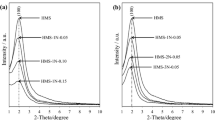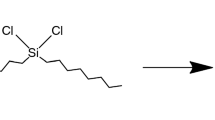Abstract
Reactions of hydrolytic polycondensation of bis(triethoxysilane) [(C2H5O)3Si]2C2H4 (or [(C2H5O)3Si]2C6H4) and functional agent (C2H5O)3Si(CH2)2P(O)(OC2H5)2 (alkoxysilanes molar ratio of 2: 1 and 4: 1, fluoride ion catalyst and ethanol solvent) yielded powder-like xerogels that contained phosphonic acid residues in the surface layer. Their treatment with boiling concentrated hydrochloric acid resulted in transformation of functional groups ≡Si(CH2)2P(O)(OC2H5)2 into acid groups ≡Si(CH2)2P(O)(OH)2. The methods of IR, 1H MAS NMRm and 13C, 29Si, 31P MAS NMR spectroscopy showed the following (1) The surface layer in the initial xerogels contains not only phosphorus functional groups, but also some non-hydrolyzed ethoxysilyl groups as well as silanol groups. (2) The hydrochloric acid treatment of the initial xerogels causes the hydrolysis of not only ethoxy groups in the phosphonic acid residues, but also most residual ethoxysilyl groups. (3) Vacuum drying of xerogels after acid treatment forms ≡Si(CH2)2P(O)(OH)-OSi≡ links in their surface layer (not more than 20% of phosphorus-containing groups). (4) According to 29Si CP MAS NMR spectroscopic data, boiling acid treatment relatively enriches the xerogel structure T2 and T3 units and accounts for the higher rigidity of the hybrid framework. These units also account for retention of the porous structure in these xerogels over time, while most initial xerogels have porous structures that collapse in 12–18 months of storage. The acid-treated xerogels were attributed to microporous adsorbents (having specific surface area of 620 to 760 m2/g). According to the AFM data, both initial and acid-treated xerogels contain almost spherical aggregates of the primary particles (globules).
Similar content being viewed by others
References
Sullivan, A.C. and Wilson, J.R.H., US Pat. 0077889 A1, 2004.
Zub, Yu.L. and Parish, R.V., Stud. Surf. Sci. Catal., 1996, vol 99, p. 285.
Zub, Yu.L. and Chuiko, A.A., Colloidal Silica: Fundamentals and Applications, Bergna, H.E. and Roberts, W.O. (Eds.), Boca Raton: CRC Press, 2006, p. 397.
Avnir, D., Klein. L.G, Levy, D. et al., The Chemistry of Organic Silicon Compounds, Rappoport, Z. and Apeloig, Y. (Eds), Chichister: Wiley, 1998 vol. 2, p.2317.
Voronkov, M.G., Vlasova, N.N., and Pozhidaev, Yu.N., Appl. Organometal. Chem., 2000 vol. 14, p.287.
Pozhidaev, Yu.N., Doctoral Diss. (Chem.), Irkutsk: IrIKh SO RAN, 2004.
Bezomber, J.-P., Chuit, C., Gorriu, R.J.P., et al., J. Mater. Chem., 1998 vol. 8, p.1749.
Aliev, A., Ou, D.L., Ormsby, B., et al., J.Mater. Chem., 2000 vol. 10, p.2758.
Carbonneau, G., Frantz, R., Durand, J.-O., et al., J. Mater. Chem., 2002 vol. 12, p.540.
Jurado-Gonzalez, M., Ou, D. L., Sullivan, A.C., et al., J. Mater. Chem., 2002 vol. 12, p.3605.
Dudarko, O.A., Mel’nik, I. V., Zub, Yu.L., et al., Kolloid. Zh., 2005 vol. 67, no. 5, p.753.
Shea, K., J., Loy, D.A., and Webster, O.W., J. Am. Chem. Soc., 1992 vol. 114, p.6700.
Dabrowski, A., Barczak, M., Stolyarchuk (Shvaykovska), N.V., et al., Adsorption, 2005, no. 11, p.497.
Melnyk, I.V., Stolyarchuk, N.V., Dudarko, O.A., et al., Abstracts of 4th Int. Conf. on Sol-Gel Materials, Kliczkow Castle, Poland, 2006, p.61.
Gordon, A. and Ford, R., Sputnik khimika (Chemist’s Guide), Moscow: Mir, 1976, p.541.
Brunauer, J.S., Emmet P.H., and Teller, E., J. Am. Chem. Soc., 1938 vol. 60, p.309.
Barrett, E.P., Joyner, L.G., and Halenda, P.P., J. Am. Chem. Soc., 1951 vol. 73, p.373.
Shvaykovska, N.V., Mel’nik, I.V., Yurchenko, G.R., et al., Khim., Fiz. i Tekhnol. Poverkh., 2004, no. 10, p.80.
Lin-Vien, D., Colthup, N.B., Fateley, W.G., et al., The Handbook of Infrared and Raman Characteristic Frequencies of Organic Molecules, San Diego, CA: Academic Press, 1991, p.504.
Finn, L.P. and Slinyakova, I.B., Kolloid. Zh., 1975 vol. 37, no. 4, p.723.
Cardenas, A., Hovnanian, N., and Smaihi, M., J. Appl. Polym Sci., 1996 vol. 60, p.2279.
Dabrowski, A., Barchak, M., Dudarko, O.A., et al., Pol. Chem. J., 2007 vol. 81, p.475.
Dudarko, O.A., Mel’nik, I.V., Zub, Yu.L., et al., Neorg. Mater., 2006 vol. 42, no. 4, p.413.
Rouquerol, F., Rouquerol, J., and Sing, K., Adsorption by Powders and Porous Solids, Principles, Methodology and Application, New York: Academic Press, 1999, p.467.
Author information
Authors and Affiliations
Corresponding author
Additional information
Original Russian Text © I. V. Mel’nik, N. V. Stolyarchuk, O. A. Dudarko, Yu. L. Zub, A. Dabrowski, M. Barczak, B. Alonso, 2010, published in Fizikokhimiya Poverkhnosti i Zashchita Materialov, 2010, Vol. 46, No. 2, pp. 174–182.
Rights and permissions
About this article
Cite this article
Mel’nik, I.V., Stolyarchuk, N.V., Dudarko, O.A. et al. Bridged polysilsequioxane adsorption materials containing phosphonic acid residues. Prot Met Phys Chem Surf 46, 206–214 (2010). https://doi.org/10.1134/S2070205110020073
Received:
Published:
Issue Date:
DOI: https://doi.org/10.1134/S2070205110020073




